
GLENN LONEY'S SHOW NOTES
By Glenn Loney, May 1, 2002

| |
|
Caricature of Glenn Loney by Sam Norkin. |
|
[02] Horton Foote's "The Carpetbagger's Children"
[03] Ellen McLaughlin's "Helen"
[04] Naomi Iizuka's "36 Views"
[05] John B. Keane's "The Matchmaker"
[06] Suzan-Lori Parks' "Topdog/Underdog"
[07] Trish Vradenburg's "Surving Grace"
[08] Michele Lowe's "The Smell of the Kill"
[09] Paul Rudnick's "Valhalla"
[10] MTE's "The Golem"
[11] Ivan Turgenev's "Fortune's Fool"
[12] Henrik Ibsen's "The Master Builder"
[13] Bernard Pomerance's "The Elephant Man"
[14] Sternheim & Martin's "The Underpants"
[15] Paul Osborn's "Morning's at Seven"
[16] S. N. Berhman's "No Time for Comedy"
[17] Max Frisch's "Andorra"
[18] Kathleen Turner in "The Graduate"
[19] "Thoroughly Modern Millie"
[20] "Sweet Smell of Success"
[21] "Mamma Mia!"
[22] "Oklahoma!"
[23] "Menopause: The Musical"
[24] Monteverdi at BAM: "Il Ritorno d'Ulisse in Patria"
[25] Monteverdi at BAM: L'incoronazione di Poppea"
[26] Monteverdi at BAM: "Orfeo"
[27] Handel at City Opera: "Agrippina"
[28] Wolf-Ferrari & Domingo at the Met: "Sly"
[29] At the New Victory: Fred Garbo's Inflatable Theatre Company
You can use your browser's "find" function to skip to articles on any of these topics instead of scrolling down. Click the "FIND" button or drop down the "EDIT" menu and choose "FIND."
How to contact Glenn Loney: Please email invitations and personal correspondences to Mr. Loney via Editor, New York Theatre Wire. Do not send faxes regarding such matters to The Everett Collection, which is only responsible for making Loney's INFOTOGRAPHY photo-images available for commercial and editorial uses.
How to purchase rights to photos by Glenn Loney: For editorial and commercial uses of the Glenn Loney INFOTOGRAPHY/ArtsArchive of international photo-images, contact THE EVERETT COLLECTION, 104 West 27th Street, NYC 10010. Phone: 212-255-8610/FAX: 212-255-8612.
For archival versions of Glenn Loney's past columns, please try our internal search engine.
After the Rigors of the Humana Festival:
Meanwhile… Back On and Off Broadway—
With the Tony Nominations fast approaching, producers broke the theatre-drought of the past winter with a number of handsome new stagings. A virtual Embarrassment of Riches, leaving few free evenings for opera, ballet, dance-theatre, or concerts. Forget about a Quiet Evening At Home With a Good Book…As in previous seasons, however, the Outer Critics Circle was first in line with Award Nominations. Soon to be followed by the Drama Desk and the Antoinette Perry Awards nominations.
As Secretary of the OCC—but not the one who "keeps the minutes of the meetings"—I can reveal that we are the first because no one would pay much attention to our awards if they followed the Tonys.
Preceding the other two prestigious Award Nominations Announcements, the OCC's list of favorites receives immediate attention in print and broadcast media. This helps not only the designated productions and artists, but also the reputation of the OCC.
We know how to pick Winners!
This is usually reinforced by the subsequent choices of the Drama Desk and the Tony Voters. I used to vote for the Tonys—back when I was More Important and on the A- List—but I still vote for Drama Desk Awards.
In some award-categories this season, the pickings have been pathetically slim, however. For Outstanding Revival of a Musical, the OCC could nominate only Oklahoma! and Into the Woods, which is Sondheim, but without an exclamation-point…
As for New Musicals, Thou Shalt Not could not hope to make the final-cut of four candidates against the competition of Mamma Mia!, Sweet Smell of Success, Thoroughly Modern Millie, and Urinetown. The latter won my special admiration and my vote.
Winnowing candidates for New Plays and Outstanding Performances was much more difficult. There were so many impressive possibilities this season! More of them Off-Broadway than On, unfortunately…
New Scripts/Novel Productions:
Horton Foote's Carpetbagger's Children [****]
At Lincoln Center, it's bittersweet Nostalgia-Time with Horton Foote revisiting Harrison, TX, and its down-home folks.The Carpetbagger's Children is a long, long saga of the family of a Union soldier who returned to the South after the War Between the States and profited greatly from the lands he purchased from ruined plantation-owners.
The tale is told by three of his daughters in intersecting monologues. Brian Friel does this kind of thing much better, as in Molly Sweeney. But it is still not a very effective dramatic-form.
Considering the time-span sprinted across by the women's varied memories, as a real play, in acts & scenes, this would have proved an epic longer than Wagner's Ring. But not so interesting…
Foote is fortunate in his cast, however: Jean Stapleton, Roberta Maxwell, and his own daughter, the affecting Hallie Foote. Michael Wilson staged.
Ellen McLaughlin's HELEN [***]
Ellen McLaughlin was Tony Kushner's Acrobatic & Angelic Messenger in his own epic: Angels in America. So she is lucky to have his collegial services as director of her new version of Helen of Troy.Just as there are many versions of the Amphitryon Legend—witness the French drama Amphitryon 38—so also are there multiple variations on the Legend of Helen, Paris, Menelaus, and the Destruction of Troy.
One version insists that the real Helen was waiting out the Trojan War in Egypt. The Helen young Prince Paris carried off to Troy as his reward for choosing Aphrodite as the most beautiful of the Goddesses was Not the Real Thing. The Trojan Helen was a Copy, an Illusion.
Athena got her revenge on Paris for losing the Beauty Contest, by backing the Greeks and totally obliterating Troy, its Royal House, and its Heroes.
In her Egyptian Seclusion, however, Helen received only faint reports of distant dramas. Her situation has been vividly imagined by the composer Richard Strauss and his librettist, Hugo von Hofmannstal. One of his most avant-garde operas—unfortunately infrequently performed—is Die Aegyptische Helene.
In order to keep posted on events in far-off Troy, Strauss equips Helen with an All-Seeing Mussel. In a wonderful Munich Opera staging, this looked very much like a State of the Art TV Monitor encased in a giant clam-shell.
Ellen McLaughlin has been similarly inspired to update the action. The real Helen—whose name of course is a variant of Ellen—is trapped in a lavish hotel-room on the Gizeh Plateau, with an excellent view of the Sphinx and the Three Pyramids.
She is dying of boredom, waited upon by Marian Seldes, disguised as Flora Robson as George Bernard Shaw's Fatateetah, in Gabriel Pascal's film of Caesar and Cleopatra.
Although Ms. McLaughlin shows steady improvement as a playwright of real imagination and invention, she has not yet attained GBS's mastery of the bon mot or the witty & trenchant philosophical summary.
But she's on her way, strongly assisted by stage-director Kushner, designers Michael Yeargan, Susan Hilferty, Scott Zielinski, Gina Leishman, and Paul Huntley.
But all this top-notch design and direction would be as nothing were it not for the Helen of Donna Murphy. With the amusing support of Seldes, Johanna Day as a heifer-eared Io, Phylicia Rashad as a fiercely armored Athena, and Denis O'Hare as a worn-out Menelaus.
Naomi Iizuka's 36 Views [*****]
This stunning co-production was first seen at Berkeley Rep's new theatre, the Roda, on Addison. At the Public Theatre, it looked just as much at home, with its high-tech multi-media design.The 36 Views refers to a famous—and now almost priceless—sequence of antique colored wood-block prints of Mount Fuji. But its application in Naomi Iizuka's fascinating and challenging drama of chicanery in the Art World refers to multiple layers of appearance and reality.
With metal-framed screens—resembling Japanese shojis, but with rapidly changing computer-controlled projections—rising and descending, sliding on and off, director Mark Wing-Davey and his team of designers have created a kind of Machine of Ever-Changing Images with which the actors intersect in fast-moving scenes.
Design Kudos for the team which based this structure on the Japanese board-game of GO: Douglas Stein, Myung Hee Cho, David Weiner, Matthew Spiro, and Ruppert Bohle!
Stephen Lang plays an attractive but free-wheeling art-dealer, who is in danger of entrapment by an enterprising female journalist-investigator. His over-intelligent and slightly flaky assistant John is translating—or has he written it himself?—an exceedingly rare Pillow-Book.
Experts demand to see the original manuscript. An angry Asian artist who has aided the dealer before in semi-scams helps John fabricate sample pages. Careers and reputations are at stake in this convoluted drama.
Next time you are tempted by an Utamaro print at the 69th Street Armory, be careful! It could be a fake. And that Albrecht Dürer print of the Virgin surely is…
John B. Keane's The Matchmaker [****]
In her return to the New York stage, this time Anna Manahan does not have to have her skull bashed in at every performance as she did in The Beauty Queen of Leenane.In this Irish Matchmaker—no relation to Thornton Wilder's Dolly Levi—she plays a variety of lonely women looking for a mate. Des Keogh is the wily matchmaker, warning and advising his clientele via the postal services. He also gets mail from his sister in Philadelphia, but this is no Philadelphia, Here I Come!
It is low-key and enormously amusing. Keogh also plays an odd Anglo-Irish lord, who wants a comely young wife, but who will settle for an agreeable boy!
Michael Scott staged for the Irish Repertory Theatre.
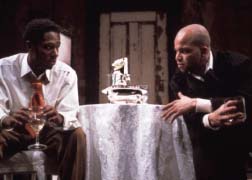 |
| BOOTH & LINCOLN TOGETHER AGAIN!--Mos Def & Jeffrey Wright in "Topdog/Underdog." Photo: ©Michal Daniel/2002. |
Suzan-Lori Parks' Topdog/Underdog [****]
OK, so I wasn't crazy about Susan-Lori Parks' The America Play some seasons ago at the Public Theatre. A Black actor, dressed as Abe Lincoln, was trapped in a sea of tanbark. His daytime job was impersonating Lincoln at a Penny-Arcade, as visitors paid to play John Wilkes Booth and assassinate him.This surreal drama won Parks kudos and prizes. I was baffled.
Not so with Topdog/Underdog. Jeffrey Wright plays an impersonator named Lincoln—who seems the same Abe Lincoln in Parks' earlier drama.
But this time, he's seen at home, living in a shabby room with his frustrated, unemployed brother, whose name is Booth, wonderfully played by Mos Def.
Bro' Lincoln was once on the street with a very successful Three-Card Monte game. But he lost his touch and his confederates.
So he lets people shoot at him in the arcade. He brings home the only bacon available to both brothers, but he has to sleep in an armchair. Booth hogs the narrow bed and dreams of becoming a Monte Master himself.
He doesn't have the magic, however, so envy leads to tragedy in this largely hilarious family-drama.
George C. Wolfe—chief of the Public Theatre—has deftly staged this powerful play on Broadway, after a Village tryout. Mos Def and Jeffrey Wright are NOT TO BE MISSED!
Trish Vradenburg's Surviving Grace [***]
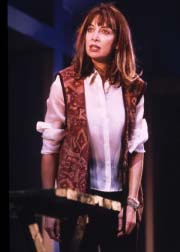 |
| ILLEANA DOUGLAS SURVIVES MOTHER GRACE Photo: ©Joan Marcus/2002. |
Its stars—Illeana Douglas and Doris Belack—had been asked to gush to each other about how wonderful it was to be back working in the theatre and how true-to-life the play is in dealing with mother-daughter relationships.
From my experience of Mother-Daughter-Watching, the duo is distinctively New York Jewish. Irish and Italians, each in their own ways, nag and complain differently.
Perhaps the producers seized on the female generational conflict as a selling-point, rather than serve notice that it's more importantly about the Heartbreak of Alzheimer's and the need for a cure.
Belack plays Doris—the quintessential East Coast Jewish Mother—who gradually descends into the dark night of Alzheimer Forgetfulness. Her loving husband—on a Florida respite from hospital visits—swiftly abandons her and plans to remarry.
But an untested miracle drug temporarily restores Doris's wits and tart tongue. She even turns up at her husband's wedding.
And then the end comes all too sadly and suddenly. This is a laff-riot with a crushing denouement.
Trish Vradenburg has Douglas narrate the story, illustrated by scenes along the way. Doris's tragedy could have been much more powerful as a real interactive play, not a memory-recall by her TV-producer daughter.
But then it wouldn't have been a laff-riot, appealing to scores of Jewish Mothers.
David Gallo's ingenious set-design did much to give meaning and form to the docu-drama quasi-comic text. Jack Hofsiss directed with skill.
Even with its faults, it is an interesting, even a challenging drama. Audiences beyond New York will surely respond to it. But regional theatres should avoid those awful ads!
Michele Lowe's The Smell of the Kill [*]
Onstage at the Helen Hayes, the entire cast of three actresses are supposed to be able to smell the bloody aging game downstairs in the basement's giant freezer.The audience can also smell something, but it's not in the basement. It's right there on stage, despite the heroic efforts of Lisa Emery, Jessica Stone, and the wonderful Claudia Shear—Blown Sideways Through Life and Dirty Blonde, her Mae West fantasy.
They impersonate three wives who have nothing in common except their gun-loving, animal-killing husbands. At intervals, the men have a communal dinner—cooked of course by the wives, who like to huddle in the kitchen as the men brag about their hunting and fishing exploits.
Their spouses are not only gross, insensitive, and abusive, they are not apparently even great in bed.
So, somehow, when the never-seen men go down to look at ice-rigid game in the freezer, the heavy steel door swings closed and locks.
Their desperate pounding on the ceiling—heard through the kitchen-floor—grows more feeble and dies away. The keys to the freezer are at hand on the kitchen-counter, but who wants to spoil an otherwise perfect evening?
One hopes this production—and the play it replicates—will die away as well.
Paul Rudnick's Valhalla [****]
Ludwig, the Mad King of Bavaria, was actually the Second of That Name. His grandfather—with whom he is too often confused—was King Ludwig I, who lost his throne because he wouldn't give up his notorious mistress, Lola Montez.Ludwig I, like his art-loving grandson, also had an Edifice Complex, creating a virtual Renaissance Florence and a Neo-Classic Athens and Rome along Munich's grand boulevards.
For these extravagances, he was though Mad as well. So he had to abdicate, as his grandson also would.
Ludwig II—a closeted homosexual—failed his People by having neither a mistress nor a queen. But he did build the fairy-tale castle of Neu Schwanstein, the mini-Versailles of Herren Chiemsee, and the rococo palace of Linderhof, complete with Wagnerian underground Venus-Grotto.
Deposed because his ministers feared his ongoing and astronomical construction expenditures—and his Sun King fantasies—he was replaced by his younger brother, King Otto.
But Otto didn't really replace him on the throne, as Otto was certifiably insane and had been for years confined in a padded room in Schloss Fürstenreid outside Munich.
A close relative, also an Otto, became the first King of Greece, after it was liberated from centuries of Turkish rule. His madness was also soon apparent, so he was shipped back to Bavaria, where the Wittelsbach Ruling Family has long had the reputation of some loose-screws over ages. At the time of Germany's defeat at the close of World War I, it was the longest continually-ruling dynasty in Europe. Longer than the Habsburgs!v Ludwig II's beloved cousin, Sissi, became Franz Josef's Empress of Austria. The sumptuous Viennese musical, Elizabeth, tells her tragic story. As does the new Dream of Paradise, a Bavarian musical about Ludwig's sad and lonely life—performed eight-times per week in a purpose-built theatre on a lake below Neu Schwanstein.
Paul Rudnick, one of America's most brilliant satirist-parodists—he scripted The Adams Family—has recycled these Lugwig Legends in Valhalla, recently given three remarkable performances by the Juillard School's Drama Division.
This was only one of a five-play graduation repertory by The Stars of Tomorrow. Director Christopher Ashley and designers David Gallo and William Ivey-Long must have seen either Dream of Paradise or Elizabeth or both, so well have they recreated the most notable visual elements of Ludwig's neo-baroque Dreamworld.
Rudnick's genius has been to interweave Ludwig's tragic life with those of two amorously confused teenagers from Texas. who end up at the close of World War II at Neu Schwanstein, where one of them is shot in the back by a Nazi soldier.
The lover who survives returns to their small Texas town with a priceless jeweled reliquary—holding the heart of a long-dead Bavarian King. He insists it was given him by gratefully liberated Bavarians.
This oddly comic bit is not Pure Rudnick invention. In fact, the embalmed hearts of Bavarian Kings—removed from their bodies—are sealed in remarkable silver and gold reliquaries and taken to the great Roman Catholic Pilgrimage Shrine of Alt-Ötting. Here they are venerated—even today—by the Faithful, hoping for healings and answered prayers!
The bodies themselves—sealed in immense lead sarcophagai—are on view in the crypts of St Michael's Jesuit Church and the Theatinerkirche in Munich. I photographed them all last summer, in case anyone wants to see what they look like…
Napoleon Bonaparte's stepson, Prince Eugene Beauharnais, is also buried in St. Michaels, having served in the Bavarian Army.
But there's another aspect to the treasure in Rudnick's Valhalla.
After World War II, a young and handsome—and closeted—US Army lieutenant returned to his native town in Texas. With him in his duffel-bag he brought rich medieval treasures from the time of Henry the Lion, Germany's first king.
Lt. Joe Bob Meador told family and friends—as in Rudnick's oddly arresting serio-comedy—that they were gifts from people in the German town where he was stationed.
That was the ancient East German Cathedral City of Quedlinburg. Recently—with threats of criminal trials and unspecified costly ransoms—most of these artifacts were restored to the Cathedral Treasury. This could be a play in itself!
Craig Baldwin was passionate, campy, and majestic as Ludwig II. Nathan Baesel was a good foil as James, the Texan who dies. Also outstanding: Sarah Grace Wilson, Frank Harts, Samantha Soule, and James Martinez.
These young talents are following the Juilliard Path first trod—under John Houseman's direction—by Kevin Kline, Patti LuPone, and other luminaries who got their start at Lincoln Center in the Juilliard Drama Program!
Golden Oldies Revived & Revised:
Manhattan Theatre Ensemble's THE GOLEM [***]
After the recent astonishments of MTE's handsome and unsettling production of Franz Kafka's The Castle, their staging of Leivick's The Golem was respectable, without being transforming.Monster Plays are notoriously difficult to stage, as witness various recent stage and screen versions of Mary Shelley's Frankenstein. A film with that inclusive name very nearly destroyed the credit and career of Kenneth Branagh.
Director Lawrence Sacharow avoided the dangerous temptation to equip his Medieval Jewish Golem with a Monster-Costume. Instead—rather like Billy Crudup's Elephant Man—he cast the long, lanky Joseph McKenna in the role and covered him with ash-gray makeup.
As the historic/legendary Prague Golem—animated into life with cabalistic spells by the Chief Rabbi—was made from clay, this seemed just right.
In fact, when I first went to Prague in 1956, the Sexton of the Old/New Synagogue took me up to the attic to see a box of the Actual Golem Clay! Jewish Lore doesn't get more Authentic than that!
The immediate reason the rabbi summoned up the Golem was a Jewish pogrom, incited by a Roman Catholic priest—Thaddeus [David Little] in this version of the legend. As in Spain under the Inquisition, he insisted that Jews stole Christian babies, ritually sacrificed them, and then used their blood for making matzohs.
But, in Leivick and adapter David Fishelson's retelling of the story, Thaddeus was ordering young monks to abduct and kill the babes, draining their blood into vials. This may have a bizarre resonance with those contemporary priests who have been draining other vital fluids from Christian children.
Robert Prosky, long a mainstay of the Arena Theatre in Washington, DC, was stalwart and finally greatly shaken as the Maharal rabbi who dabbles in What Is Forbidden.
[Over a decade ago, I interviewed Prosky at a Kafkaesque castle on a great lake in Lithuania. He and Sam Waterston had just arrived in Vilnius to perform Lee Blessing's Broadway hit, A Walk in the Woods!]
Ivan Turgenev's FORTUNE'S FOOL [*****]
If you grew tired of seeing Alan Bates in all those Simon Gray dramas of disappointed, disaffected London literate intellectuals—or had even quite given up on him as an actor—you need to see his revelatory performance as a shabby-gentle sponger on a neglected Russian estate.His manifest fear of being thrown out—as the young mistress [Enid Graham], long absent in Petersburg, returns with her efficient young aristocratic husband—is both comic and pathetic.
Goaded beyond reason by the meddling, mocking master of a neighboring estate—the magnificently autocratic, gossipy, and dismissive Frank Langella—Bates, as Kuzovkin, becomes riotously drunk. He either boastfully or revengefully reveals a Shocking Secret which abruptly changes everything for him.
Not entirely for the better, either. But nothing can be the same after that disclosure.
Nonetheless, Bates' epic Drunk Scene is one for the Guinness Book of Records!
Bates' handsome son, Benedick Bates, is the polished young courtier husband—who may soon prove to be a cruel master and a very cold fish indeed.
Arthur Penn staged in John Arnone's handsome setting, with Stage-Russian costumes by Jane Greenwood.
On the M2 bus uptown after the show, I met New York magazine critic John Simon. I reminded him of the time we'd seen Tammy Grimes and Farley Granger in Turgenev's A Month in the Country.
Did he remember that he'd written: "For me, however, it was only a fortnight in the country, as I left at the intermission."
"Did I write that?' he wondered. But he did grimly recall—which I had forgotten—that Tammy's daughter, Amanda Plummer, had played her daughter in the production.
Daily News critic Howard Kissell, sitting next to Simon, chimed in: "I saw Farley Granger at the opera last night!"
Better at the opera than onstage at the Music Box in Fortune's Fool…
Henrik Ibsen's THE MASTER BUILDER [***]
My speech must have been sadly slurred one morning recently. I invited a colleague to see a revival of a terminally symbolic drama by Henrik Ibsen."I have absolutely no interest in seeing a play called The Masturbator. And if you keep calling me to see things like Urinetown, Vagina Monologues, and Puppetry of the Penis, I'll get an unlisted number!"
Actually, she wasn't so far off the mark about Ibsen's Master Builder. Towers and steeples serve as symbols for masculine potency and achievement.
But the professionally insecure builder/architect Solness has no head for heights. Even when he has designed them himself.
And he has no admiration for talented young apprentices who can actually design innovative new buildings—which he knows he cannot.
It is an ancient Germanic/Nordic tradition to top out a new building with a Druidic evergreen tree. It is still common practice, even on Post Modernist office-blocks.
Long ago, when Solness [Dennis Parlato] was young and bold—and elevating himself from a mere building-contractor to the rank of architect—he astonished on-lookers by climbing a newly-built steeple to crown it with an evergreen wreath.
Young Hilda Wangel saw that feat and fell in love with her image of the Master Builder. Now that he has grown old and is finishing a castle of a house for his alienated wife [Wendy Barrie-Wilson], Hilda appears to wreak domestic and emotional havoc.
The vibrant young Construction Groupie insists that Solness must climb the tower of his new home to place the wreath. Against all sane advice, he attempts it—and falls to his death.
It is not too difficult to read the tower or the steeple as a Genital Symbol. As well as the wreath, fitting tightly around its shaft…
In the last analysis, Solness simply is not Up To It. Nor to being a big enough man to admit the genius of his long-suffering drawing-board apprentice [Paden Fallis].
J. C. Compton's revival at the Century Center—one of a five-part Ibsen Series—took ingenious advantage of the handsome Victorian decor of the former Century Ballroom. This large chamber is above the actual Century Theatre, which has been hosting Shakespeare Abridged to great success.
It's not merely metaphoric to say that the success of The Master Builder stands—or falls—on the casting & performance of the role of Hilda Wangel.
In this production, she was rather older and much more buxom than Ibsen's vision would seem to require. In addition, for some odd reason she was crammed into lederhosen, looking rather like a Nazi Scoutmaster. Or mistress…
Add to that disturbing moving-image an extremely annoying, noisy, and highly animated enthusiasm for Solness and His Works and you have the makings of a fall that would put Humpty Dumpty to shame.
Bernard Pomerance's THE ELEPHANT MAN [****]
This compelling docu-drama was first seen in Manhattan some years ago in the basement of St. Peter's Church, now known as the York Theatre. Based on the true story of the hideously deformed John Merrick—suffering from an incurable bone and tissue disease—it soon moved to Broadway, toured widely, and became a film.The new staging—by Sean Mathias, with designs by Santo Loquasto—is in the grand tradition of Bertolt Brecht's Epic Theatre productions at the Berliner Ensemble. The rapidly changing scenes are swiftly moved along with Brecht's half-curtains, projected quotes, and elemental, even clinical, set-props.
Instead of suggesting Merrick's ghastly head with mask or make-up, Billy Crudup achieves a muted effect by twisting his features. This is easier on the eyes—especially for those who cannot bear to look at physical deformities—but it lessens the impact of the gradual emergence of a high intelligence and a delicate sensibility in the creature which at first seemed little more than an ignorant, unfeeling beast.
Rupert Graves is excellent as the troubled Society physician who helps Merrick. But Kate Burton is memorable as Mrs. Kendall, the famed London actress who became Merrick's friend and advocate.
This is an altogether outstanding production—not to be missed. But, owing to the subject-matter—or "I saw it way back in 1979 at the Booth"—it is apt to be missed by too many to keep it open long.
Philip Glass has provided "original music." But then one would hardly expect Glass to crib from Mozart. Can you imagine a program-credit like this: Un-original Music Composed by Philip Glass…
Carl Sternheim & Steve Martin's UNDERPANTS [***]
 |
| GOSSIP IN "THE UNDERPANTS"--Cheryl Lynn Bowers & Kristine Nielsen Photo: ©Dixie Sheridan/2002. |
What the text should have said: "The World Premiere of a Largely New Parody by Steve Martin."
Sternheim's Die Hosen is, in fact, a much admired classic of the Modern German Theatre. It is frequently produced in Europe—even Post-Modernized—but never in such a frenetic mode as this new adaptation by cinema-comic Martin.
To give Martin and stage-director Barry Edelstein their respective dues, the laff-a-minute dialogue and High-Octane performances are very entertaining. But nothing like Sternheim's metaphoric critique of pre-World War I Berlin.
Byron Jennings is very amusing as the rigid & now hysterical Prussian civil-servant whose wife Louise [Cheryl Linn Bowers] has just lost her knickers as the German Kaiser was passing by in parade.
Surely everyone—including the Kaiser—must have seen this disastrously immodest accident? As it turns out, the Kaiser was so impressed that he pays the couple a surprise visit!
Designer Scott Pask has created a compact lower middle-class Wilhelmian apartment for the action. And, to enhance the symbolism of the play's title, he has shrouded the thrust stage with an enormous three-sided curtain composed entirely of women's underpants. The stage is even flanked and banked with stacks of knickers.
Angela Wendt's pertly period costumes complement the set and enhance characters and actions.
But Martin's text is—at least in spirit—a long way off from Sternheim and Imperial Berlin. Why did he pick up on Sternheim anyway?
How does he know about him—this comic who never even heard of the eminent drama-critic John Gassner?
When the Outer Critics Circle gave Steve Martin the John Gassner Award—which was established to encourage new young American playwrights—he joked, as he received the plaque and the check: "Who the hell is John Gassner?"
Steve Martin certainly deserved an award for his Picasso at the Lapin Agile, but not as a young playwright. Previously, all the OCC nominators—except your scribe—had voted the Gassner Award to Ann Meara. Mrs. Jerry Stiller, however, at that point in her long comic career, needed no encouragement. Nor did Martin.
As John Gassner's last collaborator—and author of the biographical introduction to his last collection of critiques: Dramatic Soundings—I was distressed. The intentions of the Gassner Family, in establishing the award, had been quite clear.
Paul Osborn's MORNING'S AT SEVEN [****]
What is the mysterious charm of Paul Osborn's Morning's at Seven?Currently enjoying a handsome and delightful Lincoln Center Theatre revival on Broadway at the Lyceum Theatre, it had already been revived on that same stage over a decade ago.
Why not bring back Osborne's On Borrowed Time again as well? That was revived not so long ago at Circle-in-the-Square—when it was still the producing organization Theodore Mann had created.
My guess is that this fresh-as-paint revival is a subtle response to the horrors of 9/11. Taking New York audiences back to a happier time in The Midwest of the Heart and Mind…
The time, according to the program, is 1938, shortly before the horrors of World War II, when America and Americans were much more innocent. And also Isolationist…
From the looks of John Lee Beatty's lovely Carpenter-Gothic twin-houses and Jane Greenwood's costumes, the time could be 1928. Maybe even 1918?
This is a very Old-Fashioned Vision of Mainstream Small-Town America. Thornton Wilder and Horton Foote could be out back, writing Our Town and Carpetbagger's Children!
Add to the visual delights of the production—and the pacifying nostalgia for a simpler, happier time—an All-Star Cast, and you have the ingredients of a very satisfying Evening in the Theatre.
Dan Sullivan has effectively staged Elizabeth Franz, Julie Hagerty, Buck Henry, Piper Laurie [!], Christopher Lloyd, William Biff McGuire, Estelle Parsons, Frances Sternhagen, and Stephen Tobolowsky.
Can this young man be somehow distantly related to Grace Topolovsky?
If you remember, that was Mona's Real Name in Dames at Sea. This delightfully innocent parody of 42nd Street is now at the Goodspeed Opera House, headed for Broadway!
S. N. Behrman's NO TIME FOR COMEDY [***]
If it's not something In the Air, it must be In the Water! This nostalgia for pre-World War II Broadway hits…The facile society farceur, Sam Behrman—worried about impending Nazi horrors in Europe—decided to write a comedy more in tune with the seriousness of unfolding events abroad than the It-Can't-Happen-Here American Public was accustomed to.
The Mint Theatre—now justly admired for its record of handsome, if small-scale, revivals of modern British and American classics—has spread an Art Deco sheen over Behrman's 1938 Broadway scene. The Very Same Year as Morning's at Seven!
Simon Brooking is Behrman's playwiting alter-ego, Gaylord Easterbrook. Leslie Denniston is his actress-wife, Linda Page. She's At Liberty, waiting for a Good Script, preferably a starring vehicle crafted by her witty husband, momentarily suffering from a bad case of Writer's Block.
Shawn Sturnick is Makepeace Lovell, an effete unmarried Playboy, who makes much over handsome women. If he romances them after lunch or dinner is a question. Today, he'd be openly gay. Or Cole Porter-Closeted…
Kent Paul staged in Tony Andrea's Deco apartments.
Max Frisch's ANDORRA [***]
Although there are some similarities in this metaphoric melodrama of small-minded small-town Europeans turning savagely on a neighbor with The Visit of the Old Lady, by Frisch's fellow-Swiss dramatist, Friedrich Dürrenmatt, unfortunately Frisch was the lesser talent of the two.But he may be on an Off-Broadway Roll just now. Larry Luckinbill is to appear in Frisch's The Firebugs at the Neighborhood Playhouse in June!
This—like Andorra—is another anti-Nazi play, suggesting how complicit the German people were in permitting the Nazi Take-Over in 1933.
Originally titled Biedermeier und die Brandstifter, Firebugs is a metaphoric black comedy which sets up an all-too-well-meaning couple who invite homeless strangers into their house. Even though these sinister men are carting in gasoline and other firestuffs…
In Andorra's small-town capital, there's also very much a sense of It-Can't-Happen-Here. But the citizens find out that it can, very much to their cost.
Central to the action is a difficult, dissident school-teacher, who years ago rescued Andri, a Jewish boy from across the border up North—where they are bigoted, cruel, and militaristic.
Even though Andorrans pride themselves on their freedom from racial and religious prejudice, almost everyone feels it necessary to comment on the young man's "Jewish" attitudes, behavior, and gestures.
Frisch has made these a catalogue of subtly Anti-Semitic slurs. But even the young man's adoptive teacher-father won't permit him to marry his beloved foster-sister, Berlin. Is he also an Anti-Semite?
No. The secret of the play—which will save you having to rush off to the Lucille Lortel Theatre on Christopher Street—is that he has lied. He is in fact the real father, and his son—by a woman from the North—is NOT JEWISH!
That revelation does not save Andri. No one believes it. Least of all the victorious invaders.
Their "Witch-Finder General" makes all the men take off their shoes. He has only to inspect their feet to detect their Jewishness.
This is Frisch's ingenious metaphor for the actual Infallible Nazi Detection Method. This was to have suspects drop their trousers.
In Europe at that time—and certainly in pre-war Germany—Christian men and boys were customarily not circumcised.
Romania's distinguished director, Liviu Ciulei, staged this elemental revival. Why he chose a cast so given to over-acting and under-achievement is a puzzle.
The distinguished—and eminently admirable—translator and critic Michael Feingold provided the English/American text.
From Screen To Stage/A Dramatic Reversal:
Kathleen Turner in THE GRADUATE [***]
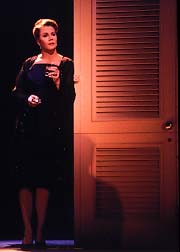 |
| KATHLEEN TURNER FULLY-DRESSED IN "THE GRADUATE. Photo: ©Joan Marcus/2002. |
If you have seen the movie—or rented the video—you have already enjoyed a more effective telling of this tawdry tale than you will see 3-D onstage at the Plymouth.
This reworking of Chas. Webb's novel and the screenplay by Calder Willingham and Buck Henry—now onstage at the Lyceum!—delighted London's West End theatre-goers recently.
They couldn't get enough of Kathleen Turner in the nude. She was succeeded by Mick Jagger's ex, Jerry Hall! Wow!
You do get to see more of Turner nekkid in the dim light than you did of Nicole Kidman in David Hare's boring The Blue Room.
Why do the Brits love this semi-secretive naughty-nudity so? Do shows such as No Sex Please, We're British explain it?
Rob Howell has provided a handsomely louvered setting: a veritable Box of Jalousies. These shutters open variously to accommodate scene & mood shifts, but this is largely a bedroom comedy.
Jason Biggs plays the nervous teen-age nebbishy Woody Allen role, immortalized on screen by Dustin Hoffman. Alicia Silverstone is Mrs. Robinson's daughter—whom he also hopes to bed, but as his young wife. Not as his all-too-experienced mistress…
Turner looks terrific, by the way. But you already knew that, didn't you?
Musicals Old & New:
THOROUGHLY MODERN MILLIE [****]
If there's a video of the movie-musical with Julie Andrews, you can go ahead and rent it. But don't imagine it will compare with the experience of Millie Live On Stage!Sutton Foster is a Sudden Star as Millie.
She is also the very talented and attractive sister of Hunter Foster, currently starring in Urinetown! It's only a matter of time before they are paired on Broadway in a brother/sister all-dancing, all-singing musical, just like Fred and Adele Astaire!
Adele married what used to be called a "Titled English Lord." Lords are titled by definition, but so what? Foster's Millie is not aiming so high. She wants to marry her boss.
Handsome though he [Marc Kudisch] is, what he really wants is a good stenographer. The fact that he continually calls Millie "John"—and replaces her with a young illegal immigrant Chinese boy-steno-whiz—suggests he has different priorities.
Harriet Harris is an hilarious Beatrice Lillie reincarnation as Mrs. Meers, the solicitous proprietor of a Manhattan rooming-house for single young women. If they are orphans and down on their luck, she drugs them and ships them off to Shanghai and a Life of Shame as White Slaves!
Her schemes come hysterically unstuck however when she tries to Shanghai Miss Dorothy Brown [Angela Christian]. Miss Brown is indeed an orphan, her mother having died long ago.
But her step-mother is the Josephine Baker-like cabaret-singer sensation of Broadway, Muzzy Van Hossmere [Sheryl Lee Ralph]. This sexy black chanteuse—smothered in glittering sequins and dripping with silvery tassels and fringes—is the widow of the fabled Millionaire Van Hossmere.
And the feckless Jimmy—who seems to have no job or ambition in life, other than to marry Millie—proves to be Muzzy's adored step-son.
So it all Turns Out All Right for Millie. But not for the wicked-witchy Mrs. Meers!
This show is a complete Art Deco Delight, thanks to the ever-changing settings of David Gallo, the sparkling costumes of Martin Pakledinaz, and the ingeniously colorful lighting of Donald Holder.
Rob Ashford's energy-charged and highly Deco Stylized choreographies compare handsomely with those of 42nd Street.
Michael Mayer directed with a knowing eye for the comedy and parody of the book, as well as its great potential for spectacle and glamour.
Millie ought to have a long, long run. Frankly, I'd like to see it again and again. It's not just that I love Musicals and Art Deco in general. But also that this show is so supercharged with energy and fun that it is enormously enjoyable, charging up its audiences' batteries as well.
SWEET SMELL OF SUCCESS [***]
Alas, that cannot be said descriptively of this show, whose smell is rather acrid. This lackluster musical, now at the Martin Beck, is in the same neighborhood as The Smell of the Kill. But there is the odor of Dead [Wild] Turkey about this one…As with The Graduate, you may want to rent the video instead—if there is one.
Despite the best efforts of the usually ingenious director Brit, Nicholas Hytner, on stage the action lacks interest and focus.
That is partly a problem created by John Guare's less-than-powerful adaptation of the film. And by the run-of-the-mill tunes of Marvin Hamlisch and lyrics of Craig Carnelia.
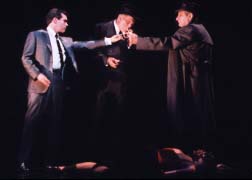 |
| THREE'S A CROWD IN "SWEET SMELL OF SUCCESS. Photo: ©Paul Kolnik/2002. |
That fine character-actor John Lithgow doesn't really command center-stage in the Burt Lancaster role. Nor is Bryan d'Arcy James another Tony Curtis.
Nor are Brit Bob Crowley's set-and-costume designs the equal of the memorable designs he has created for Carousel on Broadway. Or for Don Giovanni at the Salzburg Festival…
The all-purpose dancing/singing chorus has no real dramatic function—nor even distinctive identifies—in various scenes. So the talented Brendan Gill Award-winning Christopher Wheeldon's choreographies seem lost in the background.
Worst of all, this has to be the darkest, most gloomy musical about Broadway Night-Life ever! The skyline skyscraper backgrounds are uniformly dark, black, and shadowed.
A few pitiful neon-signs descend to indicate changes of scene, but they are too few and too low-wattage-tentative. Saving on Electricity is not what this show needed.
A timely Word of Advice to lighting-designer Natasha Katz: LIGHT UP THE SKY!
It is not too late to re-light this sadly sagging show. But it no longer possible to do anything about its mis-fired visual and textual concepts…
MAMMA MIA! [****]
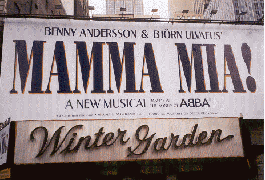 |
| Photo: Glen Loney |
I was told that—as it was virtually Sold Out pre-opening—there simply were not enough press-tickets to accommodate all the potential awards-voters. So I could see it in late spring in time to vote.
But not in time to nominate… And certainly much too late to file a timely review.
So I really shouldn't write anything about this handsome, energy-charged show, if the producers and press-agents didn't have enough respect for this New York Theatre-Wire web-site—and for this column—to provide press-tickets.
For that matter, I shouldn't write a line for I'm not a fan of pop music fads. As a lifelong listener only to Good Music Stations, I somehow missed the heyday of the success of ABBA's songs.
Unlike the thousands of much younger Boomers who are lining up to see this show at the handsomely restored Winter Garden Theatre, created long ago as a venue for Al Jolson.
Well, I have to report that Mamma Mia! is a far cry from Al Jolson's Mammy.
It is somewhat awkwardly scripted—inspired clearly by the film, Buona Sera, Mrs. Campbell—to accommodate hit songs which were definitely not written as a suite for a London or New York musical.
Nonetheless, the creaky plot does provide excuses for big production numbers of various songs, which send audiences into ecstasies of dates, dinners, and love remembered.
The Epic Curtain-Call—with even more ABBA Hits and some sensational glittering costume-changes—suggests that this show didn't need a book at all.
With the fabulous costumes and constantly moving set-props of Mark Thompson, it could have been quite as good as a Giant Choreographed Concert in Costumes. Given high-octane energy, of course, by a dynamic cast, led by Louise Pitre.
OKLAHOMA! [****]
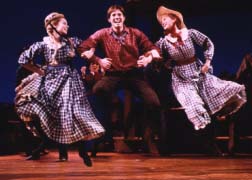 |
| EVERYTHING'S UP TO DATE IN "OKLAHOMA!" Photo: ©Michael Trench/2002. |
Anthony Ward—who also designed sets & costumes for Monteverdi's Il Ritorno di Ulisse at BAM—has created a somewhat toy-town-surreal lonely prairie landscape. Including a functioning toy-train…
His costumes are colorful. His cornfield-drop—with actual similated cornstalks—flies up into the grid above. But onstage, it can be penetrated by comely young Oklahoma Territory maidens, looking for beaux. It is not really as High as an Elephant's Eye, after all…
Returning the Lynn Rigg's original midwestern local-color melodrama, Green Grow the Lilacs, Trevor Nunn has darkened the book's lyric texture, making the moody, brooding hired-man Jud Fry [Shuler Hensley] more ominous and more interesting.
In fact, this revival is altogether more dark and brooding than its sunny Broadway original. Which I saw as a UC/Berkeley student-usher at San Francisco's Curran Theatre all those years ago when Oklahoma! was on tour in the late 1940s.
As Ado Annie, Jessica Boevers is no Celeste Holm. For that matter, the current cast cannot compete with memories of the creators of the major roles.
Nonetheless, Andrea Martin is an admirable Aunt Eller, and Josefina Gabrielle is an aloof Laurey. Patrick Wilson is an attractive but light-weight Curly, with Justin Bohon cute as a bug's ear as Will Parker.
Only Ali Hakim is an almost smarmy racist slur on Persian Peddlers. This show was mounted in London before 9/11, so its creators cannot be Getting Even for Middle Eastern Terrorism. What could they have been thinking of?
MENOPAUSE: The Musical [***]
This title may well be off-putting to potential audiences—especially women of a Certain Age. But, in a season with successful shows bearing titles like Urinetown, The Vagina Monologues, The Full Monty, and Puppetry of the Penis, buying tickets to a thoroughly amusing and attractively staged musical about Menopause should not embarrass anyone.This is not a For Girls Only show. Husbands and husbands-to-be can learn a lot from the witty songs and skits about the curses of Hot Flashes, Over-Eating, and the Heartbreak of Cellulite.
There is even a provocative number about what ladies can do for loving when their Significant Others start sleeping on the sofa. Jeanie Linders has crafted book & lyrics with a sure sense of how to sell a show on such a difficult topic.
Kathleen Lindsey has directed her foursome of talented performers with an eye for style and vitality. Joy Lynn Matthews is a Force of Nature, abetted by Mary Jo McConnell, Carolann Page, and Marnee Hollis. One of this trio is an Understudy—but if I hadn't been alerted, I would never have known, as they are all so professional and totally delightful.
Patty Bender has provided attractive dance-routines for Theatre Four's intimate stage. And Jesse Poleshuck has transformed it into an Art Deco Mini-Music Hall. Martha Bromelmeier's handsome costumes complete the visual illusion.
MUSIC-DRAMA—Beyond the Mere Musical:
When it is brilliantly designed, directed, produced, and performed, Opera and Music-Drama can be the most astonishing and rewarding theatre-experiences imaginable. Far more fascinating than mere dramas, comedies, or even plays-with-music and musical-plays.Why then do so many Theatre & Musical Comedy fans insist that they don't go to opera because "they wouldn't understand it"?
All of the recent productions noted below—at BAM, at Lincoln Center, and beyond—were eminently theatrical. And marvelous musically as well!
The Monteverdi Cycle at BAM—
Il Ritorno d'Ulisse in Patria [****]
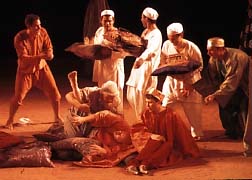 |
| TALIBAN AT BAM?--Monteverdi's "Return of Ulysses." Photo: ©Elizabeth Carrecchio/2002 |
Several battens hung with hundreds of long thin green plastic cables—with their ends gleaming with light—provided a suggestive semi-curtain.
But there were few other devices of stage-dressing. The costumes and the characters in action and in song—with the inventive direction of Adrian Noble—created the ever-changing stage-pictures.
A triangle of sheer white cloth did descend briefly from the flies to undulate in suggestion of Ulysses' ship's sail on the roiling seas.
In this opera—as in The Odyssey itself—the Greek Hero returns to Ithaca and his patient wife Penelope after long years of god-ordained confused wandering and bizarre adventures.
In the meantime, Penelope has been besieged by scores of royal suitors who want not only free board & lodging while they court this apparently widowed queen, but also to marry her and sieze Ulysses' Kingdom.
Athena—who protects Ulysses even from the ongoing wrath of Poseidon—has him return to his palace as a shabby old man. And she transports his son, Telemachus, through the air from Crete.
A challenge is set the suitors: Penelope will wed the man who can string Ulysses' fabled bow. In legend, it is so strong that only the Hero himself can do this.
They all fail. The old stranger not only strings the bow easily. He then proceeds to kill all the suitors with arrows to their hearts. In Monteverdi's version, only three bulls-eyes are required!
As with the other Monteverdis at BAM, this Ulisse cast was almost uniformly admirable. As the Hero and his wife, Kresimir Spicer and Marijana Mijanovic were especially notable.
Others who made an impression—both as singers and actors—included Paul-Henri Vila, Katalin Karolyi, Olga Pitarch, Eric Raffard, and Cyril Auvity.
One visual curiosity of this production was designer Anthony Ward's decision to set Ithaca somewhere in Arabian Nights Territory. Courtiers and servants looked like Bin Laden and the Al-Queda in more tranquil times.
Turbans abounded. At least Penelope didn't have to wear a Burkah!
Nonetheless, this production was certainly more appropriate to helping the libretto and score achieve their intended effects than one shown at the Bavarian State Opera not so long ago.
The Munich Ulisse took place entirely inside a dark old Greek Taverna, acted out as an old folk-tale by the contemporary staff of the bar and its customers. Including a very large dog, with a man inside it. Don't ask…
L'incoronazione di Poppea [****]
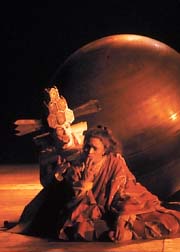 |
| AS THE WORLD TURNS--"Coronation
of Poppea" at BAM. Photo: ©Marco Borggreve/2002 |
Whether the Collector's Edition rocks were locally rented—or flown courtesy of KLM from Amsterdam—they could have been made of plastic with much less cost and effort. But then the Act II setting also included an immense jumble of rumpled metal, which might also have been more simply replicated in plastics. In the event, it burst into flames—on cue—so that ruled out styrofoam substitutes.
In fact, the three distinctive stage-pictures for the three acts of Monteverdi's masterpiece were all quite striking, even memorable. Even more impressive, however, were the unusual costumes of Japan's Emi Wada.
The finale costume for Poppea's maid Arnalta—camply sung and played by Jean-Paul Fouchécourt—was a surrealist riot of fan-pleated fabrics. It deserves its very own case in the Metropolitan Museum's Costume Collection. Or in Amsterdam's Rijksmuseum!
Some of the costumes were so sculpturally monumental that they took some attention away from the artists wearing them. Nor did they always add anything definitive to the characters. But they were great to look at.
Pierre Audi's arbitrary stage-direction, however, was often so bizarre that it worked against the costumes, sets, characters, emotions, and the plot. That two of the principals—declaring their undying love—should move away from each other on stage seemed odd.
Gender-blind casting of countertenors and sopranos in male and female roles also obviously confused a number of BAM opera-goers. At one point, the [female] Nero—Briggite Balleys—seemed to be having a passionate affair with his aide-de-camp, Lucano [Mark Tucker].
Most of the voices were magnificent, however, so Monteverdi's beautiful madrigal-influenced arias and duets soared in splendor. Andrea Silvestrelli's vibrant basso made his Seneca magisterial.
Cynthia Haymon was an exultant, exalted Poppea, Rome's new Empress. I remember her long ago as Sojourner Truth in Thea Musgrave's interesting opera about this heroic Black woman and the Underground Railway, in Norfolk, Virginia.
That production was directed by Gordon Davidson of the LA's Mark Taper. What happened in rehearsal I do not know. But Haymon broke her leg. Nonetheless, she gamely sung the premiere in a cast! She is a real trouper!
But then, aren't we always wishing performers Good Luck by saying: "Break a Leg"?
Orfeo [*****]
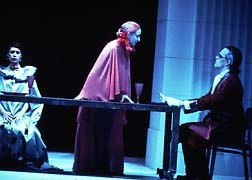 |
| DINNER IN HADES--Chicago
Opera's "Orfeo" in Brooklyn. Photo: ©Liz Lauren/2002.b |
When the curtain rose at BAM's Harvey/Majestic Theatre, the stage was ablaze with pure white light. This is an effect long favored on European opera-stages, in contrast to American preferences for modulations of color for mood and atmosphere.
The pristine white setting was a neo-classic wall upstage, pierced by three great arched french-window bays. A few stark black classic chairs and a long black table were the sole set-props.
Director Diane Paulus and conductor Jane Glover conceived their vision of Striggio's libretto as opening with a High Society reception for the well-born Eurydice and her Bohemian artist-lover, the celebrated singer Orpheus.
Accordingly, all the men were formally dressed, in a handsome variety of evening-wear. The women were wearing stunning gowns and jewels.
In the midst of all this glittering excitement, Euridice was fatally stung by a serpent in the garden. Thus began Orpheus' lament for his lost love and his quest beyond Life into the darkest depths of Hades, to win back Euridice.
Director Paulus ingeniously helped every performer—even those whose function was largely choral—to develop a distinctive character. Even the elegant waiters reacted to various party-guests in diverse but particular ways.
The effect was rather like an opera performed in a great private palace by extremely talented amateurs as a very special evening's diversion.
There was, however, nothing amateur about the voices and performances. While Laurence Dale's Orfeo occasionally sounded almost hoarse as he let extremes of emotion devour him, most of the remarkable cast was elegantly restrained and musically precise.
Outstanding were Valérie MacCarthy as Euridice, Thea Tullman as La Musica, Andrew Funk as Pluto, and Jacqueline Wall as Proserpina. But all the members of the chorus—as party-guests and servants—were also admirable vocally and as characters.
As with the previous two Monteverdi productions in this BAM cycle, the orchestra played the score on "authentic instruments."
Even More Early Opera at Lincoln Center:
Georg Frideric Händel's Agrippina [*****]
The very next night after her Orfeo Triumph at BAM, Jane Glover was at the New York State Theatre, conducting another early opera with her distinctive zest and emotional involvement. In the pit on the podium, she responds with almost as much physical action and facial expression as the players on stage.This brilliant new New York City Opera production of Handel's Agrippina was in the same visual vein as the Chicago Opera Company's Orfeo. But, if anything, it was even more visually and vocally splendid. And even more inventive!
Premiered in summer Upstate by the Glimmerglass Opera, this co-production was also in modern formal dress, with some period accents. Thanks to the designers—John Conklin, Jess Goldstein, and Mark McCullough—its Post-Post-Modernist Look made it seem miles ahead of design-concepts at the Met.
Inspired by the Classical Theatre—as well as the Renaissance—Conklin provided several three-sided scenic Periaktoi. Each face showed a different Neo-Classical Architectural Collage.
Arches, columns, cornices, and stone-work—built in low relief—were dully gleaming with gold-leaf. Rotated and rolled about—with various simple but elegant set-props, including a variety of enormous sculptural heads of Emperor Claudius—these elements suggested Imperial Rome as it might have been in a Noël Coward comedy.
Indeed, with the ingenious stage-direction of Lillian Groag and the eager cooperation of the multi-talented cast, this early opera seria—despite its tense moments and threats of betrayal and death—proved both lively and richly comic.
Poppea—wonderfully sung and acted by Nancy Allen Lundy—was besieged by not one, but three lovers. Including Emperor Claudius and his stepson-successor Nero. I last saw her as Curley's Wife at the Bregenz Festival in Of Mice and Men. She is altogether more sophisticated in Agrippina—but the hormones are raging in this opera as well.
Also outstanding were Brenda Harris as a Machiavellian Empress Agrippina, Kimberly Barber as a whiny, wimpy Nero, David Walker as a sex-starved Otho, and Gregory Reinhart as a grandly hollow Claudius.
Handel was fortunate in having a Venetian Cardinal for his librettist. And this early work—composed when he was only 24—had a huge success in Venice. At the Cardinal's family's theatre, in fact.
Vicenzo, Cardinal Grimani, had the opera end happily. Claudius and Agrippina affirm their constant love. Nero renounces Poppea for Power. And Otto/Otho/Ottone is given Poppea's hand in marriage!
Rather different than the events in Monteverdi's Coronation of Poppea. But—while the singers exulted in the Handelian Happy Ending on stage—on the supertitle panel above, a rapid succession of terse announcements made clear what actually, historically happened.
Agrippina poisoned Claudius to gain the throne for her son Nero. He had his mother murdered. Followed by Poppea. Indeed, all the historical characters onstage soon died, either by foul play or their own hands.
Ah, the Glory That Was Greece! The Grandeur That Was Rome! But don't drink the water. Or the wine. You never know what they may have put into it…
At the Met: Placido Domingo Is SLY [****]
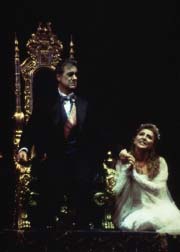 |
| DOMINGO ENTHRONED--Regal
moment in Met Opera's "Sly." Photo: ©Winnie Klotz/2002. |
Unfortunately—aside from the verismo of Cavalleria Rusticana—the operas of Zandonai, Leoncavallo, and Wolf-Ferrari began to sink virtually without a trace even before World War II.
That their works were still being staged under the fascist dictatorship of Benito Mussolini certainly did not recommend them for premieres and productions in London and New York…
Ermanno Wolf-Ferrari's Sly is one of these often unjustly neglected or forgotten modern Italian operas. Zandonai's Paola and Francesca is another, even though the Met some time ago mounted a disastrous revival, featuring Renata Scotto. This opera proved its worth, however, in a recent Bregenz Festival staging!
Now opera-director Placido Domingo—in fact, of both the Los Angeles and Washington DC Operas—has rescued Sly from undeserved obscurity. Initially—with his wife Marta Domingo as stage-director—he cast his Three-Tenors colleague, Jose Carreras, as the dissed and doomed romantic poet Sly.
But, for the Metropolitan Opera, where Domingo in Performance is a sure-fire sold-out-house, he took on the romantic/dramatic role himself.
He is surely crowding sixty by now, but his Christopher Sly was as full-voiced and powerful—and eminently dramatic—as any of his Signature Roles. Just as his recent Bayreuth Siegmund was an astonishment for such an aging tenor.
But he is now careful to avoid roles that are placed to high for his current vocal resources. Or parts in which the vocal line cannot easily be transposed downward without arousing ire of critics and opera-fans.
As Bardoloters may well imagine, the title-character of the opera Sly was suggested by that layabout brought off the street in the Induction of Shakespeare's Taming of the Shrew, and then dressed as a nobleman and made to think the play-within-the-play was being performed for his entertainment.
In Wolf-Ferrari's version—the libretto, as well as the lushly romantic score, is his alone—the imperious and thoughtless Count of Westmoreland [Juan Pons] drugs Sly in a tavern and has him wake up as a nobleman in a great palace, plied with rich foods and wines, dancing-girls, and amazing spectacles.
Designer Michael Scott has not stinted on the imaginative, haunting sets or lavish costumes!
Dolly, the Count's mistress [Maria Guleghina], is enlisted in this cruel game to play Sly's lover. In the event, his poetry and tenderness win her heart.
But, when he is rudely awakened, mocked, and finally imprisoned in the Count's gloomy wine-cellar, the deception and humiliation are too much to bear. Sly slashes his wrists with a wine-bottle shard.
As he is dying, Dolly—realizing that she has come to love him—arrives too late to save him.
This is an impressive production of an engrossing opera which ought to be more widely seen. And added to the repertory.
STOP THE PRESSES!
LATE BULLETINS! HOT FLASHES!
NEW SHOWS TOO LATE TO REVIEW!
·At the Manhattan School of Music: Albert Lortzing's DER WILDSCHÜTZ.·At the Juilliard Opera Theatre: a brand new HELOISE AND ABELARD.
·At the New York City Opera: John Philip Sousa'a THE GLASSBLOWERS.
·At the Broadhurst just off Broadway: Stephen Sondheim's INTO THE WOODS.
Other Entertainments—
Blow-Ups at the New Victory:
Fred Garbo's INFLATABLE THEATRE CO. [****]
Fred Garbo is a charming, attractive, and very athletic young creator/performer. His colorful and feather-light inflatables are Post-Art-Deco sculptures in themselves. But the way he and his partner—the lovely Brazilian Daielma Santos—inhabit and animate these structural blow-ups is often a comic and choreographic wonder.
Some—especially inflatables used as set-props—can be expanded from small handfuls of colored fabric into cubes and balls and even chairs simply by wafting them in the air to fill them.
Even those rolling, dancing, and bobbing creations which Santos and Garbo move while inside are inflated with what seem to be just a few good puffs of air. No helium. No compressed-air pumps.
This is Magic-Time, not just a lot of Hot Air. Garbo's choreographies and routines are every bit as charming as his amusing narrations.
As with almost all attractions at the New Victory, this is a show which can fascinate and delight grown-ups as well as children.
If you live outside New York—or Maine, where Garbo and Co. are At Home—do not fail to see his show when it comes your way on tour! [Loney]
Copyright © Glenn Loney 2002. No re-publication or broadcast use without proper credit of authorship. Suggested credit line: "Glenn Loney, New York Theatre Wire." Reproduction rights please contact: jslaff@nytheatre-wire.com.
| museums | recordings | coupons | publications | classified |